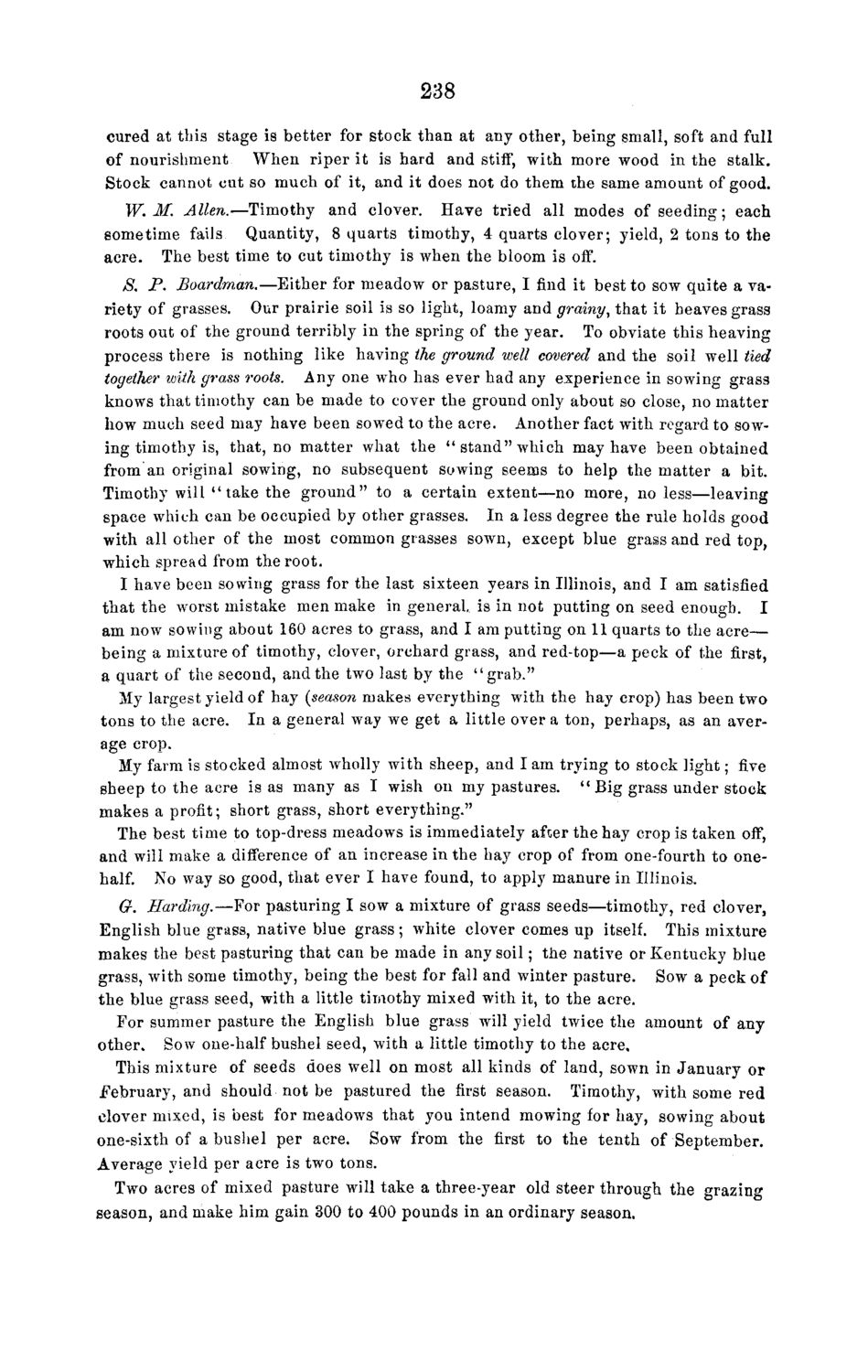| |
| |
Caption: Board of Trustees Minutes - 1868
This is a reduced-resolution page image for fast online browsing.

EXTRACTED TEXT FROM PAGE:
238 cured at this stage is better for stock than at any other, being small, soft and full of nourishment When riper it is hard and stiff, with more wood in the stalk. Stock cannot cut so much of it, and it does not do them the same amount of good. W. M. Allen.—Timothy and clover. Have tried all modes of seeding; each sometime fails Quantity, 8 quarts timothy, 4 quarts clover; yield, 2 tons to the acre. The best time to cut timothy is when the bloom is off. B. P. Boardman.—Either for meadow or pasture, I find it best to sow quite a variety of grasses. Our prairie soil is so light, loamy and grainy, that it heaves grass roots out of the ground terribly in the spring of the year. To obviate this heaving process there is nothing like having the ground well covered and the soil well tied together with grass roots. Any one who has ever had any experience in sowing grass knows that timothy can be made to cover the ground only about so close, no matter how much seed may have been sowed to the acre. Another fact with regard to sowing timothy is, that, no matter what the "stand" which may have been obtained from an original sowing, no subsequent sowing seems to help the matter a bit. Timothy will "take the ground" to a certain extent—no more, no less—leaving space which can be occupied by other grasses. In a less degree the rule holds good with all other of the most common grasses sown, except blue grass and red top, which spread from the root. I have been sowing grass for the last sixteen years in Illinois, and I am satisfied that the worst mistake men make in general, is in not putting on seed enough. I am now sowing about 160 acres to grass, and I am putting on 11 quarts to the acre— being a mixture of timothy, clover, orchard grass, and red-top—a peck of the first, a quart of the second, and the two last by the "grab." My largest yield of hay (seaso?i makes everything with the hay crop) has been two tons to the acre. In a general way we get a little over a ton, perhaps, as an average crop. My farm is stocked almost wholly with sheep, and I am trying to stock light; five sheep to the acre is as many as I wish on my pastures. " B i g grass under stock makes a profit; short grass, short everything." The best time to top-dress meadows is immediately after the hay crop is taken off, and will make a difference of an increase in the hay crop of from one-fourth to onehalf. No way so good, that ever I have found, to apply manure in Illinois. G. Harding.—For pasturing I sow a mixture of grass seeds—timothy, red clover, English blue grass, native blue grass ; white clover comes up itself. This mixture makes the best pasturing that can be made in any soil; the native or Kentucky blue grass, with some timothy, being the best for fall and winter pasture. Sow a peck of the blue grass seed, with a little timothy mixed with it, to the acre. For summer pasture the English blue grass will yield twice the amount of any other. Sow one-half bushel seed, with a little timothy to the acre. This mixture of seeds does well on most all kinds of land, sown in January or February, and should not be pastured the first season. Timothy, with some red clover mixed, is best for meadows that you intend mowing for hay, sowing about one-sixth of a bushel per acre. Sow from the first to the tenth of September. Average yield per acre is two tons. Two acres of mixed pasture will take a three-year old steer through the grazing season, and make him gain 300 to 400 pounds in an ordinary season.
| |